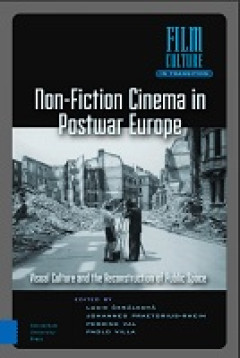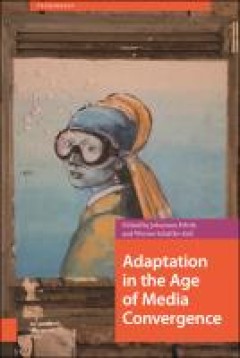Ditapis dengan
E-book Collectio Mineralium : The catalog of Holy Roman Emperor Leopold II’…
The royal entourage of the recently crowned Joseph II (1741–1790) was led by his brother Leopold (1747–1792), his future brother-in-law Albert Kasimir of Saxony-Te-schen (1738–1822), and the top officials of the Viennese central administration. This included the Court Chamber of Coinage and Mining (Hofkammer in Münz- und Bergwe-sen), the supreme authority responsible for mint…
- Edisi
- -
- ISBN/ISSN
- 9788855184946
- Deskripsi Fisik
- 285 hlm
- Judul Seri
- -
- No. Panggil
- 016.549 MAT c

E-book Non-Fiction Cinema in Postwar Europe: Visual Culture and the Reconstru…
After WWII, cinema was everywhere: in movie theatres, public squares, factories, schools, trial courts, trains, museums, and political meetings. Seen today, documentaries and newsreels, as well as the amateur production, show the kaleidoscopic portrait of a changing Europe. How did these cinematic images contribute to shaping the new societies emerging from the ashes of war, both in the Western…
- Edisi
- -
- ISBN/ISSN
- 9789048556625
- Deskripsi Fisik
- 520 halaman
- Judul Seri
- -
- No. Panggil
- 778.534 CES n
E-book Time and Soul : From Aristotle to St. Augustine
What is time?Afirst,intuitiveanswer maybethat time isadimension of thephysical universe. As such, it existsand has always existed independentlyofhuman experience.Wethus find it natural to assigntemporal identitiestoeventsthat took place millions ofyearsbefore humanity even came into being,inpar-ticular in areas such as astrophysics,geology, and palaeontology. Weknow,orwe think we know,that the …
- Edisi
- -
- ISBN/ISSN
- 9783110692754
- Deskripsi Fisik
- 109 hlm
- Judul Seri
- -
- No. Panggil
- 186 ZAC t
E-book Knowledge and Civil Society
Knowledge has been the focal concept in this book series. Beyond the many con-ceptualizations of and ascriptions to this term, knowledge denotes the human under-standing of concrete and abstract phenomena of the world in which we live. Human understanding differs from data and information in that it is built and rests in peo-ple’s minds. Whereas bits of data or parcels of commodity …
- Edisi
- -
- ISBN/ISSN
- 9783030711474
- Deskripsi Fisik
- 317 hlm
- Judul Seri
- -
- No. Panggil
- 304.2 CHA k
E-book Conservation, Markets & the Environment in Southern and Eastern Africa…
This volume is concerned with the practices, discourses, and materialities surrounding the commodification of the ‘wild’ – a topic which has found considerable academic attention in the past decade (Smessaert et al. 2020). The ‘wild’ is commonly conceived of as a conceptual opposite to the destructive tendencies of commodification. The volume’s core concern is wi…
- Edisi
- -
- ISBN/ISSN
- 9781800106642
- Deskripsi Fisik
- 513 hlm
- Judul Seri
- -
- No. Panggil
- 591.7 BOL c

E-Book City of Caesar, City of God: Constantinople and Jerusalem in Late Anti…
This volume explores the entangled history of Constantinople and Jerusalem in Late Antiquity. The two cities were powerful symbols of Empire and Church, interconnected and interdependent in multiple ways. Covering the transition between Antiquity, Byzantium, and the Middle Ages, distinguished international scholars investigate art, ceremony, religion, ideology, and imperial rule in these vibran…
- Edisi
- -
- ISBN/ISSN
- 9783110718447
- Deskripsi Fisik
- 349 halaman
- Judul Seri
- -
- No. Panggil
- 930 KLE c

E-Book Adaptation in the Age of Media Convergence
This collection considers new phenomena emerging in a convergence environment from the perspective of adaptation studies. The contributions take the most prominent methods within the field to offer reconsiderations of theoretical concepts and practices in participatory culture, transmedia franchises, and new media adaptations. The authors discuss phenomena ranging from mash-ups of novels and Yo…
- Edisi
- -
- ISBN/ISSN
- 9789048534012
- Deskripsi Fisik
- 233 halaman
- Judul Seri
- -
- No. Panggil
- 302.23 FEH a
E-book Knowledge and Networks
The book series on Knowledge and Space explores the nature of human knowledge from a geographical perspective. How to create, share, and adopt new knowledge is a core question in the social sciences. Processes of learning and knowledge creation are the result of social practice and always take place in space and in specific geo-graphical contexts. The eleventh volume is the outcome of the sympo…
- Edisi
- -
- ISBN/ISSN
- 9783319450230
- Deskripsi Fisik
- 386 hlm
- Judul Seri
- -
- No. Panggil
- 304.2 ANS k
E-book Cultures in Conflict : Religion, History and Gender in Northern Europe…
For the debates about the ultramontanization of Catholicism in the course of the nineteenth century the contrast of an early example of pilgrimages and a later case during the heyday of ultramontanism can be revealing. Though sim-ilar in social and gender aspects there are differences on the level of organiza-tion, inherent ultramontanism and transnational traits. The phenom…
- Edisi
- -
- ISBN/ISSN
- 9783631847312
- Deskripsi Fisik
- 222 hlm
- Judul Seri
- -
- No. Panggil
- 274 BLA c
E-book Changing Time : Shaping World Changemakers in Arts & Education
A multi-perspective and knowledge-oriented examination of such influ-encing variables and parameters as globalization and migration; digitization and inclusion; phenomena of media democracy; increasingly non-national citizens or those with multiple identities; the changed, mediatized social-ization of children and young people; unequal distribution of power and re-sources betwe…
- Edisi
- -
- ISBN/ISSN
- 9783839461358
- Deskripsi Fisik
- 311 hlm
- Judul Seri
- -
- No. Panggil
- 707 AXE c
 Karya Umum
Karya Umum  Filsafat
Filsafat  Agama
Agama  Ilmu-ilmu Sosial
Ilmu-ilmu Sosial  Bahasa
Bahasa  Ilmu-ilmu Murni
Ilmu-ilmu Murni  Ilmu-ilmu Terapan
Ilmu-ilmu Terapan  Kesenian, Hiburan, dan Olahraga
Kesenian, Hiburan, dan Olahraga  Kesusastraan
Kesusastraan  Geografi dan Sejarah
Geografi dan Sejarah